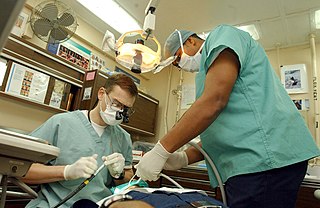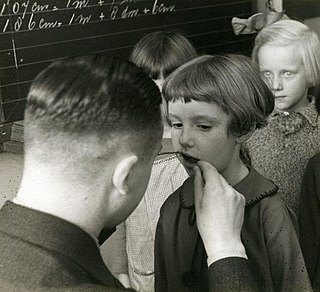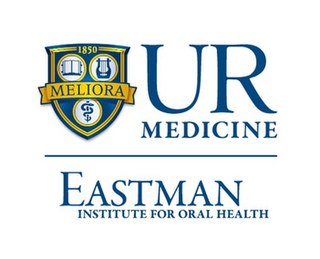There are two forms of institution-based training for general dentistry available for dental school graduates in the United States:
Contents
- General practice residency (GPR)
- Advanced education in general dentistry (AEGD)
There are two forms of institution-based training for general dentistry available for dental school graduates in the United States:
Both GPRs and AEGDs can be 1-year programs with an option available to continue for a second year or they may be a two-year program from the start. They allow the new dentist to further hone his or her skills in most of the traditionally defined disciplines of dentistry while at the same time increasing one's speed and refining one's techniques. These programs also afford trainees the opportunity to learn from the attending dentists who serve a supervisory role, something generally unavailable in private practice.
While a GPR is a hospital-based program, an AEGD is usually not and the differences between the two types of programs are generally a result of this distinction. [1] Both types of programs afford the trainee with a larger patient pool than he or she was exposed to in dental school; while dental students will typically treat 2 or 3 patients a day in multiple-hour-long sessions, these postgraduate programs are constructed so that trainees may see anywhere from 8-15 patients a day, or even more.
Programs will often emphasize the importance of managing comprehensive dental treatment plans and adjusting them based on the patient's medical condition. During training, residents may be faced with the task of managing patients that require dentistry in a hospital setting due to a compromised medical condition. Medical management of dental patients may be emphasized in weekly grand rounds and rotations through anesthesia, internal medicine, and the hospital emergency department. Some programs also provide rotations in family medicine and otolarnyology.
These rotations not only increase the trainee's knowledge and experience, but also allows physicians, resident or attending, to see how dentistry and medicine are related, allowing for a better referral relationship in future practices. This relationship is best demonstrated in tumor boards where both medical and dental residents discuss and treatment plan head and neck cancer patients.
In general, GPR programs pay higher stipends than do AEGD programs; this is because GPR residents take call and answer consults. While on call, the residents are expected to manage head and neck trauma reporting to the ER in accordance with hospital guidelines.
GPR residents may also become familiar with performing dental/oral surgical procedures in the operating room and managing the patient's stay while in the hospital. Rotation through the dental specialties increases the resident's ability to handle situations in private practice without referral to a specialist.
In both programs, the basic skills learned in dental school are improved significantly, preparing the dentist for a career in private practice or for a specialty residency program. Residents may work closely with oral and maxillofacial surgeons, allowing them to improve their skills in oral surgical procedures. Under the direct supervision of the oral surgeons, residents may expand their understanding of and increase their skill in third molar extraction, biopsy technique, pathology recognition and treatment planning in facial cosmetic and trauma surgery. Both types of programs will usually feature lecture series to further develop the knowledge that trainees received from their respective dental schools.
Applications are generally filled out at the beginning of the senior year of dental school. As with most specialty programs, GPR and AEGD programs utilize the Postdoctoral Application Support Service (PASS) operated and managed by the American Dental Education Association (ADEA). The PASS system allows all applicants to fill out a single form that is then efficiently distributed to the programs selected by the applicant. Similarly, single copies of secondary application material, such as letters of recommendation, National Board scores and the like, can be sent to PASS, which then certifies the authenticity of the copied versions it distributes to the selected programs. Overall, it allows for a more streamlined process of application over most any alternative method. [2]
After applications are in, programs will usually contact prospective candidates for interviews. After interviews are complete, the programs and the candidates will utilize the Postdoctoral Dental Matching Program, abbreviated as "the Match," to rank each other in order of preference. After the due date, a computerized algorithm sets up each candidate with the program that he or she ranked highest, although this explanation is oversimplified. For those candidates who do not match at any program, there is a "post-match" period during which programs which maintain open spots attempt to fill them on a case-by-case basis with candidates who did not match to a program. [3]
Some states require a postgraduate training program to meet requirements for licensure. For example, as of January 1, 2007, New York State requires that new dentists complete either a GPR, an AEGD or a specialty residency prior to receiving their dental license. [4]

A dentist, also known as a dental surgeon, is a health care professional who specializes in dentistry, the branch of medicine focused on the teeth, gums, and mouth. The dentist's supporting team aids in providing oral health services. The dental team includes dental assistants, dental hygienists, dental technicians, and sometimes dental therapists.
Oral and maxillofacial surgery is a surgical specialty focusing on reconstructive surgery of the face, facial trauma surgery, the oral cavity (mouth), head and neck, and jaws, as well as facial cosmetic surgery/facial plastic surgery including cleft lip and cleft palate surgery.

Residency or postgraduate training is a stage of graduate medical education. It refers to a qualified physician, veterinarian, dentist, podiatrist (DPM) or pharmacist (PharmD) who practices medicine, veterinary medicine, dentistry, podiatry, or clinical pharmacy, respectively, usually in a hospital or clinic, under the direct or indirect supervision of a senior medical clinician registered in that specialty such as an attending physician or consultant.
A number of professional degrees in dentistry are offered by dental schools in various countries around the world.

The UCLA School of Dentistry is the dental school of the University of California, Los Angeles (UCLA) located in the Center for Health Sciences building in the Westwood neighborhood of Los Angeles, California, United States. The school has several educational and training programs, conducts oral and dental health research, and offers affordable dental care at three locations: Westwood, Venice, and Inglewood. The school also participates in several outreach endeavors, including numerous health fairs during the year, STEM pipeline programs and provides dental care for underserved populations in the region. The School of Dentistry is considered among the nation's best research-intensive dental schools.
The University of Pittsburgh School of Dental Medicine is the dental school of the University of Pittsburgh (Pitt). It is located in Pittsburgh, Pennsylvania, United States. It is one of Pitt's six schools of the health sciences and one of several dental schools in Pennsylvania. It is closely affiliated with the University of Pittsburgh Medical Center. The School of Dental Medicine accepted 3.6% of applicants for the class of 2016, a record low for the school's entire history.
PGY, short for postgraduate year, is a North American numerical construct denoting the progress of postgraduate medical, dental, veterinary, podiatry or pharmacy residents in their residency programs. It is used to stratify responsibility in most training programs and to determine salary. The grade of a resident or fellow is denoted with an Arabic or Roman numeral after the PGY designation, such as PGY-3 for a third-year resident in any specialty.

Dentistry throughout the world is practiced differently, and training in dentistry varies as well.
East Carolina University School of Dental Medicine is the dental school at East Carolina University. It is North Carolina's second dental school, which enrolled its inaugural class in the fall of 2011. ECU SoDM was established to address the shortage of dentists in the rural regions across North Carolina. It serves North Carolina statewide by educating more dentists, with the primary focus of student recruitment being students who desire to return to rural and underserved areas to provide oral health care. The SoDM built 8 community service learning centers located in rural and underserved areas throughout the state. The students will complete nine-week rotations at the service learning centers during their final year of study.
The Rutgers School of Dental Medicine is the dental school of Rutgers University. It is one of several professional schools that form Rutgers Biomedical and Health Sciences, a division of the university. Established in 1956, the dental school is located in the University Heights neighborhood in city of Newark, New Jersey, United States. It is the only dental school in New Jersey and is one of only two public dental schools in the New York metropolitan area.
The Case School of Dental Medicine (CSDM) is a graduate school of Case Western Reserve University. It is an American dental school located in Cleveland, Ohio. The Case School of Dental Medicine is a clinically oriented dental school. It has been ranked consistently high with its affiliated medical school. Admission to Case Dental School has an acceptance rate of 2.1%. Over 3700 applications for admission are received every year, and 300 applicants are interviewed for the limited 75 positions. The most recently admitted class had a mean undergraduate GPA of 3.61 and a mean DAT of 20.
The American Dental Education Association (ADEA) is a non-profit organization that works to further the education of dental professionals and the advancement of academic dental programs in Canada and the United States. Founded in 1923 as the American Association of Dental Schools, ADEA is based in Washington, D.C.

The Columbia University College of Dental Medicine, often abbreviated CDM, is one of the twenty graduate and professional schools of Columbia University. It is located at 630 West 168th Street in Manhattan, New York City. According to American Dental Education Association, CDM is one of the most selective dental schools in the United States based on average DAT score, GPA, and acceptance rate. In 2017, 1,657 people applied for 84 positions in its entering class. The median undergraduate GPA and average DAT score for successful applicants in 2020 were 3.62 and 22.8, respectively.
Special needs dentistry, also known as special care dentistry, is a dental specialty that deals with the oral health problems of geriatric patients, patients with intellectual disabilities, and patients with other medical, physical, or psychiatric issues.

Pediatric dentistry is the branch of dentistry dealing with children from birth through adolescence. The specialty of pediatric dentistry is recognized by the American Dental Association, Royal College of Dentists of Canada, and Royal Australasian College of Dental Surgeons.
The practice of dentistry in the United States is overseen by several agencies, including the American Dental Association, the Commission on Dental Accreditation, and the regional boards. Ultimate licensure is the responsibility of individual states. There are roughly 190,000 practicing dentists in the United States.

The School of Dentistry is a dental school at the University of Missouri-Kansas City. The School of Dentistry is located on Hospital Hill in Kansas City, close to the University of Missouri–Kansas City School of Medicine, Truman Medical Center-Hospital Hill and Children's Mercy Hospital.
In the United States and Canada, there are twelve recognized dental specialties in which some dentists choose to train and practice, in addition to or instead of general dentistry. In the United Kingdom and Australia, there are thirteen.

Eastman Institute for Oral Health of University of Rochester is a school of dentistry located at the University of Rochester Medical Center in Rochester, New York, United States. Unlike other dental schools in the United States, it does not have an undergraduate dental program. It is affiliated with Strong Memorial Hospital.
{{cite web}}: Cite uses generic title (help)